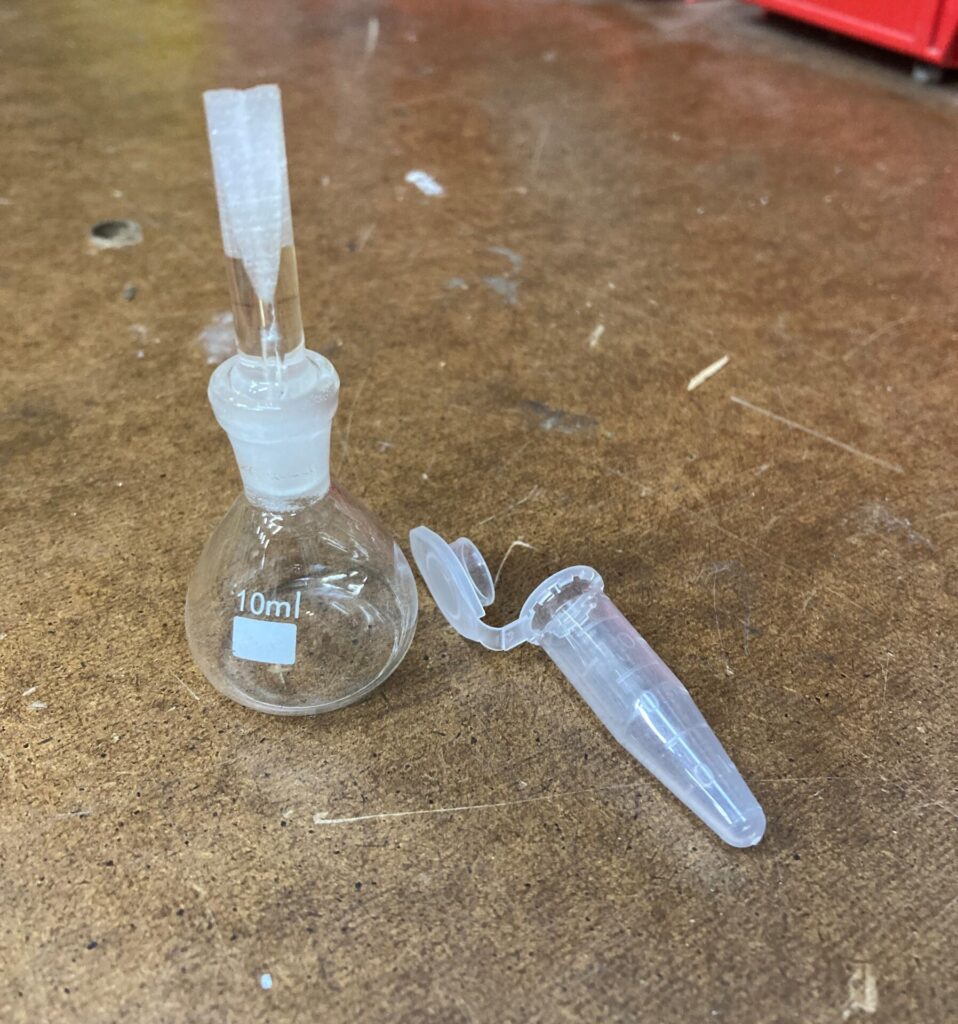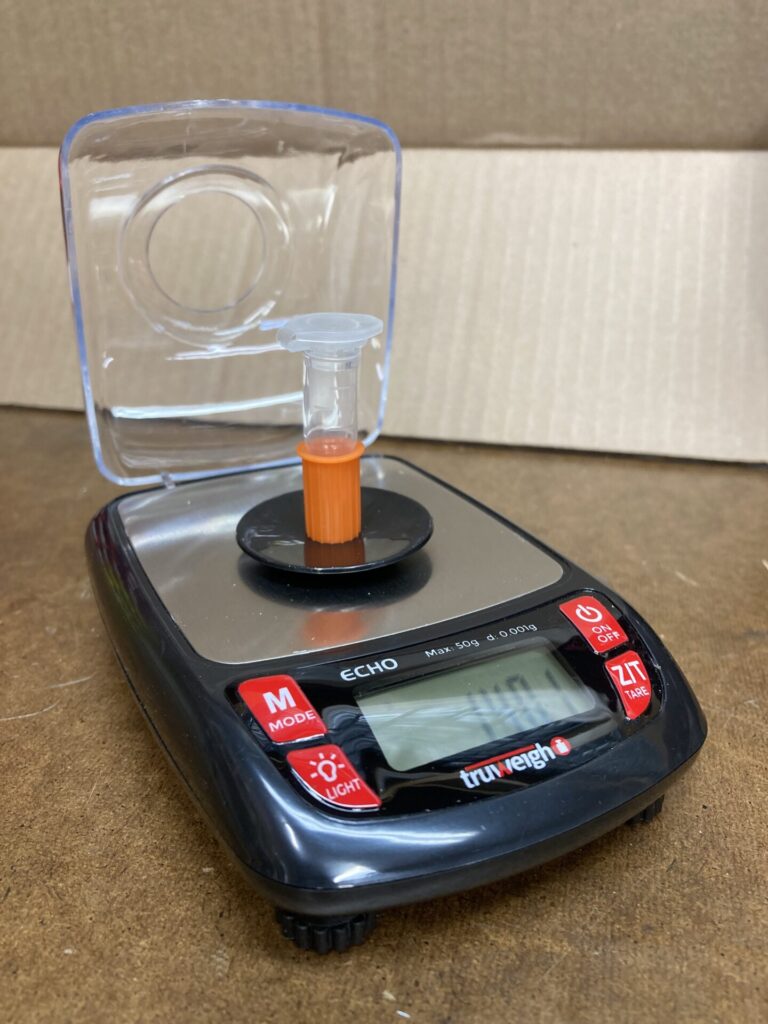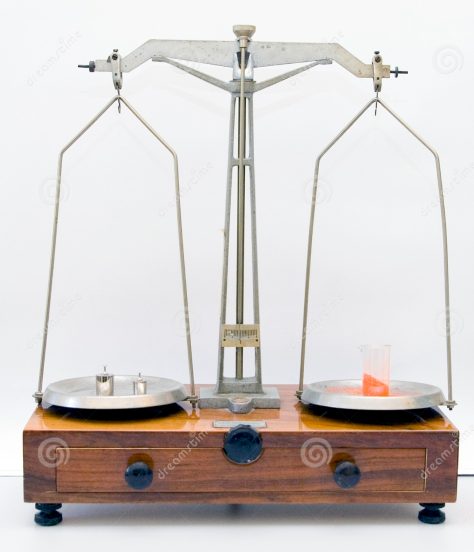Rockhounds, prospectors and ordinary folks notice with some curiosity when then pick up a rock that is heavier or lighter than expected, i.e., a sample with usual density. These often make there way to the home of the collector. Prospectors for centuries have recognized that a high density hints at a high metal content.
Density is the ratio of mass to volume, typically measured in grams/cm3. Among the properties that can be used to “zero-in” on the identity of a mineral, density is one of the best. The mineral literature often uses specific gravity in place of density. Although defined differently1, the two are numerically the same.
If samples were nice regular geometric shapes, then volume could be calculated from the dimensions and the mass determined with an accurate balance. This is rarely or maybe never the case. Another standard technique for measuring density involves the use of liquids with a range of densities. The method is simple and accurate. If the sample sinks its density is greater than that of the liquid, if is floats then the density is less than that of the liquid. Ideally a liquid is found in which the sample is suspended. Unfortunately, this technique is limited to minerals with relatively low densities. Even minerals with moderate densities require the use of liquids that are not human friendly.
The method described below is based on the “pycnometer” method described Orsino Smith2 and others. Instead of an expensive laboratory pycnometer this method uses a 2 mL plastic Eppendorf tube illustrated in Figure 1. These tubes have several advantages over typical glass pycnometer also illustrated in Figure 1. Perhaps foremost in the list is the fact that they are very inexpensive and not in the lease bit fragile.

The only modification of the tube required is to make two small holes in the cap. The author used a syringe needle and on occasion drilled the holes with very small drill bits. A syringe with a needle (22 gauge no sharp point) is required and will be used to add water to the tube.
A scale or balance capable of measuring to 1 mg is also needed. The author used a very inexpensive variety sold on E-bay. These tend to be very sensitive to the position of the sample on the pan so some means of making the position reproducible is needed3. The author’s is illustrated in Figure 2 (a screw cap from a tube of glue). The user should experiment a bit with the process of determining the mass of the tube until he or she gets reproducible results. Once the positioning problem is solved reproducible mass on the order of a few milligrams is readily accomplished.

The measurements are simple but the math may appear a bit mysterious. A little thought, however, should reveal the simplicity. Start by closing the cap and getting the mass of the tube, Mt. One tube can be used over and over, so treat them well and the repeated masses from many determinations will help with statistics. Using the syringe fill the tube with water until it escapes from the hole in the top. Wipe off any excess. Try to get the water level as close to the top of the lid as possible. As a chemist I often did things in 3’s so you should repeat the entire procedure until the mass of water is reproducible to within a few milligrams.
The mass of the water, Mwo, is the mass of the filled tube minus the mass of the empty tube. If the balance has a tare function, tare the empty tube and this will eliminate the need to subtract the mass of the tube. The volume of the water in the tube which is equal to the volume of the tube, Vt, is equal to the mass of the water divided by the density of water at the temperature of the experiment 0.998 at 22oC. Given the small difference between the density of water and 1.00, the division can be skipped and the mass used directly as if it is the volume.
Empty the tube and dry it thoroughly. Add the sample to the tube, shut the lid and again subtract the mass of the tube from the mass of the sample plus the tube to obtain the mass of the sample Ms. Its important that the mass of the sample be at least 150 mg4. If the sample is too small or the calculated volume of water too small you will not be able to get a good density.
Now fill the tube with water, making sure there are no air bubbles. Try to use the same filling technique that was used above. Pay attention to the level of the liquid and any excess water on the sides. Get the mass of the tube with the sample and again substract the mass of the empty tube to get the mass of the sample and the water Mws.
Finally, for the calculation of the density we need the mass of the sample and its volume. The density is Ms/Vs.
The mass of the sample is straight forward just Ms.
The volume of the sample can be obtained from the mass measurements. If we subtract Ms from Mws we get the mass of the water in the tube with the sample. Mws-Ms = Mw.
Mw is the volume of the water in the tube with the sample, ~Vf.
The difference between the volume of water in tube and the volume of the water that shared space with the sample, Vt-Vf, gives the volume of the sample, Vs.
The density is Ms/Vs.
A Real Example
The following is some experimental data obtained with a sample thought to be magnetite. The sample was shiny black and magnetic.
Mass of empty tube, Mt = 0.995 g.
Start with three measurements. The following masses are after subtraction of the mass of the tube (by using the tare function).
Mass of sample, Ms = 0.747 g.
Mass of water only in tube, Mwo = 2.889 or ~Vt = 2.889 cm3
Mass of water and sample in tube, Mws = 3.490 g.
Next are the calculations.
Mass of water in tube after subtraction of the sample mass, Mw = 3.490-0.747 g = 2.743
This is the volume of the water shared with the sample, Vf. ~ 2.743 cm3
Volume of sample in tube, Vt-Vf = Vs ~ 2.889-2.743 = 0.146 cm3
Density of Sample, Ms/Vs = 0.747/0.146 = 5.12 g/cm3
The reported range of density is 5.168-5.180. Given that this is a real sample with potential impurities the agreement is excellent.
Footnotes
- Density is simply the mass divided by the volume. The specific gravity is the ratio of the mass of the sample to the mass of an equal volume of water. Specific gravity has no units.
- Orsino C. Smith, Identification and Qualitative Chemical Analysis of Minerals, D. Van Nostrand and Co., 1953.
- The problem of placing the object on the center of the pan has contributed to negative reviews on some of the inexpensive balances. A little care remedies the problem. Comparisons with a laboratory balance (0.1 mg resolution) gave comparable results.
- Sample can be a collection of crumbs, a powder or a single piece but it must be pure.
